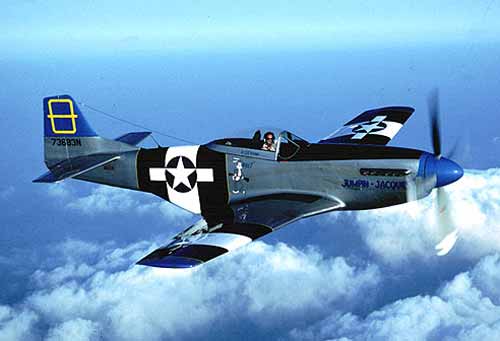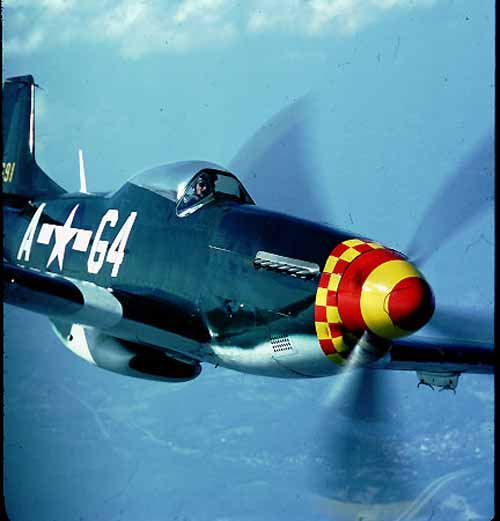PAGE THREE
 |
We couldn't have put 150
hour pilots into combat during WWII, if the Mustang were as hard
to fly as wags would have us believe. Fly it by the numbers and
it's a real gentleman. |
Surely the airplane with the most skewed reputation
is the North American P-51 Mustang. This is not to say it's over or
under-rated, just misunderstood. Next to the Bearcat, the Mustang is
probably the embodiment of everything man had learned about aircraft
design up to that point (interesting random thought: aviation was only
thirty-seven years old when the Mustang was born. We are now forty-three
years away from the P-51's birth. Have we bettered ourselves or not? [note
from editor:2010, make that seventy years. Unbelievable!]). Although
the Mustang doesn't have the runway manners of the Bearcat, the Mustang
still is possessed of nearly perfect landing gear geometry and, as
long as you respect the power and stay halfway awake, you'll always
find yourself more or less in the middle of the runway pointed in the
direction you're supposed to be.
THE FABLED TORQUE OF THE MUSTANG IS largely a matter of how fast
you decide to drop the hammer. And most of it is P-factor, not torque.
But make no mistake; given the proper combination of rapid power application
and hoisting the tail too quickly and aggravating what is a sizeable
amount of gyroscopic precession because of the huge prop, you'll find
it is absolutely deserved of the reputation. You generally get in a situation
like that because you haven't flown the numbers, haven't read the book
or didn't believe it if you read it. God help you if you treat the throttle
like a 7EC Champ. Drop the hammer hard and get behind on applying the
massive amounts of rudder required when you do that, and you’re
in for a real ride. Come up with the power slow and smooth and it’s
a no brainer. However, there's nothing more spectacular than a Mustang
ground looping on takeoff with full power. It'll fold the gear, grind
a wing off past the aileron, break the fuselage in half and curl the
prop up like an over-heated spider. Yes, it's easy enough to keep in
the central envelope but, once again, step over into margin for error
and you'll find the prop thrashing at the dangerous edge of the envelope
in micro-seconds.
Although most high-performance birds are actually easier to handle
in many situations than their featherweight brethren, they do share
a basic characteristic: if something goes wrong in the air, it's serious.
For instance, even though Merlins and Pratt & Whitneys were built
to eat 20mm shells and keep on truckin', they also like to catch on
fire, blow oil and coolant lines and eat valves. Airplanes like that
also have a whole lot of forty-year-old systems [ed:now seventy-year-old
systems] that like to go haywire at the wrong time. And, of course,
if something does go
wrong, you aren't going to glide down to any cow pasture and make a thistledown
landing in the wheat. Unless you're damned lucky, you're going to tear
up the airplane, all the time worrying about where those hundreds of
gallons of avgas are going.
High-performance pilots earn their reputation by knowing how to function
when they're deep into the margin of error. That is what separates the
men from the supermen. It's hard to judge a high-performance pilot's
aeronautical prowess, unless you see one of them successfully three-point
a burning Mustang in a gusty, 40-knot, 90-degree crosswind with only
one gear leg down and locked. Then you know you're looking at a real
super-jock.
 |
A Fairchild 71 is typical
of the breed in that they land slow and are generally well behaved,
but once you get it started and are outside the inner envelope,
you don't have much to work with. Between the weight,CG and gear
geometry, nothing is working for you. |
Antique pilots, on the other hand, should probably be forced to take
out real estate licenses since bombing along with those cranky old engines
means they are constantly evaluating the real estate below with the
idea of unintentionally taking closer look. Although the antiques
have nowhere near the potential for system breakdown as the high performance
birds do, those old engines just love to quit and throw pieces off into
the surrounding vicinity. Sezekleys, for instance, have tie rods to prevent
jugs from leaving the airplane. The Warner radial invented cracked cylinders
and seventy-five hours is considered to be an excellent TBO on OX-5s.
Some of those engine are over ninety years old, and probably weren’t
reliable when they were new and they definitely ain’t new now!
Fortunately, almost all antique airplanes are up to their cabane struts
in pasture goodness, and everything they do is done at a super-leisurely
rate, although they do have the glide ratio of a two-ton divit. So, when
the antique pilot finds himself out in the margin of error, at least
he'll have plenty of time to enjoy everything that's going wrong.
So, the next time you begin to hand accolades to a pilot's performance,
sit down and think for a second: just because he's out there pushing
around an airplane with a hoary reputation, doesn't mean he automatically
deserves your applause. Put it in context. Real aeronautical prowess
is handling an airplane in a situation that puts out-of-the-ordinary
demands on the pilot, when measured against the airplane type, and he
is still able to retreat from the point of no return to the green arc
in the performance envelope.
Some of the very finest pilots in the world are flying Cubs and some
of them are flying Mustangs. And then there are pilots who shouldn't
be flying anything but are flying both. Bottom line: it's not what
you fly that counts. It's how you fly it. BD
|

